- NLI Research Institute >
- The Impact of ISO 14000 on Corporate Management- Companies Adapt to the Green Marketing Era -
The Impact of ISO 14000 on Corporate Management- Companies Adapt to the Green Marketing Era -
Font size
- S
- M
- L
| Introduction
Interest is growing in the ISO 14000 series of global standards for environmental management. Of these, there is a worldwide trend to acquire certification under ISO 14001, also known as the "passport for international transactions." There is no doubt that early in the next century, environmental considerations will be among the main standards of corporate behavior. Since ISO 14001 was officially published less than one year ago, its potential impact is not yet clear. However it is expected to play an important role because it is a concrete global rule rather than a concept. It will also change the way companies do business.
1. Qualitative and Quantitative Change in Environmental Problems From the perspective of causes and countermeasures, there are basically two types of environmental problems − local problems and global problems (Figure 1). It is becoming increasingly clear that not only local environmental problems but global problems must be resolved. (1) Local Environmental Problems: Specific Acts of Environmental Pollution Industrial pollution and urban pollution became issues in Japan in the 1960s. Since the causes of pollution were relatively easy to identify and damage or injury to persons and the environment were limited in area, the problems were regarded as manageable with anti-pollution technology and administrative measures. The concept of dealing only with specific acts of environmental pollution that were local in scope and direct in nature led to enactment of the Basic Anti-Pollution Law and Law to Protect the Natural Environment. Specific measures included implementation of emission standards, and penalties were imposed only for violations. However, as global warming (leading to possible climate change) and waste disposal problems surfaced in the late 1980s, the limits of the concept of specific acts of environmental pollution became increasingly clear. (2) Global Environmental Problems: Omnipresent Sources of Pollution Global environmental problems − including global warming, destruction of the ozone layer, acid rain, and destruction of tropical rain forests − are interrelated, wide ranging in scope, and pose a common vital problem for humankind that affects future generations. Needless to say, the primary cause of these problems is none other than human activities. Even though normal activities in daily life and business may not violate environmental standards, and even though individual activities have an imperceptible impact on the environment, the aggregate effect of all activities produces problems of a global scale. In recognition of this, the Basic Environment Law enacted in 1993 seeks to preserve the global environment by transforming the society and economy, and the Basic Environment Plan was approved by the Cabinet the following year. Based on the equitable sharing of burdens, the plan calls for voluntary and active participation in pro-environmental activities not only of central and local governments, but all members of society including businesses, the general public, and NGOs, and describes their expected roles.
|
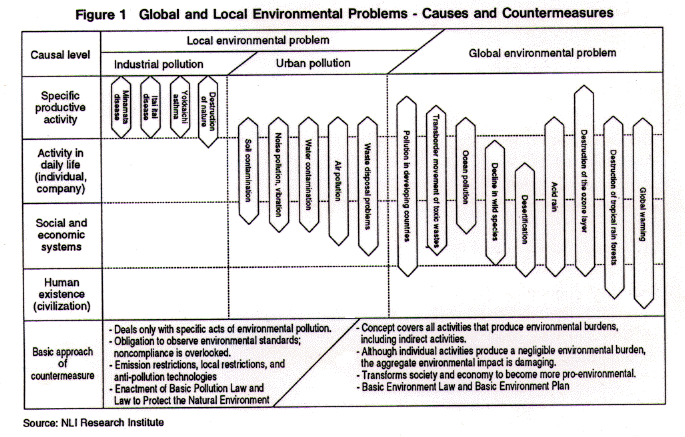
|
2. Changes in Corporate Environmental Behavior The Basic Environment Law describes the responsibility of corporations, and calls on corporate management to become more pro-environmental. Against this backdrop, more companies are upgrading their environmental operations from being supplemental to essential. (1) Environmental Management of Companies Looking at the status of environmental management among listed companies, we find that participation is spreading (Figure 2). In descending order, the most common measures being taken are establishing environmental management policies (50 percent), setting specific goals (40 percent), formulating specific action plans (30 percent), and auditing environmental activities (30 percent). While it is desirable to see more companies establishing environmental management policies, if we tentatively define it to include up to environmental audits, 30 percent of listed companies presently conduct environmental management. Broken down by sector, the proportion is high among companies directly engaged in toxic materials and energy consumption such as manufacturing and electricity and gas supply, and low in finance, insurance, real estate, and service sectors.
|
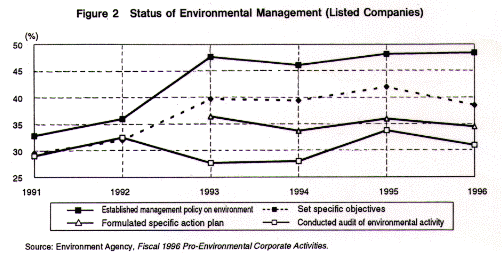
| (2) Environmental Efforts by Sector
In manufacturing, the emphasis is presently placed on the manufacturing stage, primarily reduction of industrial waste and conservation of energy and resources. Measures are also being taken in the development stage to develop products that impose a smaller burden on the environment, in the distribution stage to reduce packaging materials, and in the waste disposal stage to introduce control table for waste materials (Figure 3). Due to the nature of production, environmental considerations are becoming an essential aspect of the manufacturing sector. Other sectors have begun to do what can be done: reducing construction waste materials in the construction sector, thorough maintenance of vehicles in the transportation sector, reducing containers and wrapping in the distribution sector, and reducing paper usage in the finance and insurance sectors.
|
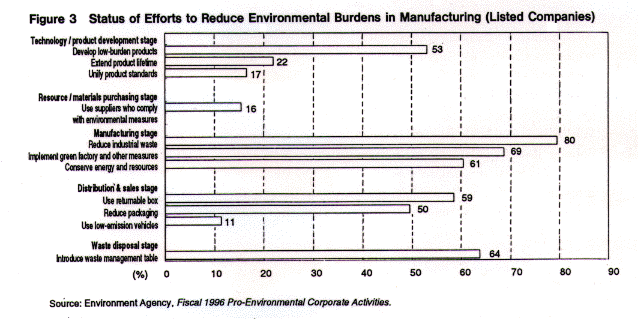
| (3) Disclosure of Environmental Information by Sector
In the future, we predict that disclosure will become important not only in financial information but environmental information. This will affect not only corporate competitiveness and the profits of interested parties, but the trustworthiness of companies in terms of environmental risk. Presently, Japan has no disclosure requirements for environmental information. Some companies release an environmental reports while others release absolute no environmental information. A survey taken in fiscal 1993 by Tohmatsu & Co., an auditing corporation, offers data on the status of environmental disclosure. According to the survey, 304 of the 2,168 listed companies made mention of the environment. Most of the content described future issues rather than present conditions. Broken down by sector, there was an overwhelmingly high proportion in sectors closely related to the environment such as paper and pulp, oil and coal, electricity and gas. Next highest were chemical, pharmaceutical and transportation equipment sectors. On the other hand, finance and insurance were very quiet, due partly to their lack of perceptible impact on the environment.
3. Emergence of ISO 14000 The ISO 14000 series of standards was designed to build a framework for reducing environmental burdens. Conformance standard ISO 14001, which contains standards for approval by third parties, calls for a strong commitment by top management to decision making and organizational and sustained improvement. (1) Overview of ISO 14000 The ISO 14000 series refers to the standards for building an environmental management system published by the International Organization for Standardization, and is comprised of the following six parts.
(2) Goals of the ISO 14001 Certification System Before understanding the specific requirements for an environmental management system under the widely discussed ISO 14001, we first need to understand its basic characteristics:
Immediately after the publication of ISO 14001, Japan adopted JIS Q 14001, a domestic standard with the same content, based on the TBT (Technical Barriers to Trade) Agreement of the WTO. JIS certification by a domestic inspection registered institution (receives certification from the top certifying organization) is immediately accepted as the equivalent of ISO 14001 certification.
|
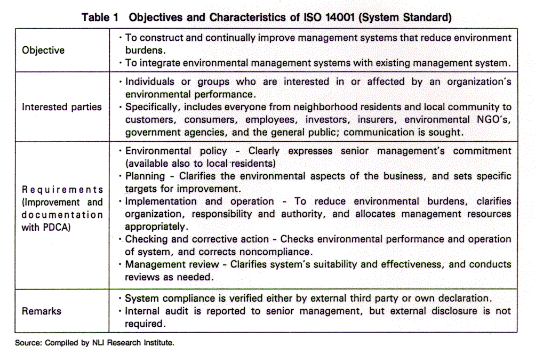
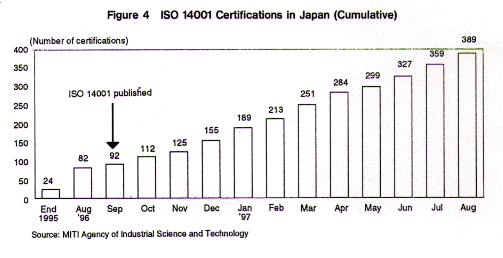
| (3) ISO Certification Status in Japan
As of the end of August, one year after the publication of ISO 14001, Japan has 389 certifications. The majority are for factories of large companies, and the number increases every month and should continue to grow for the time being (Figure 4). The manufacturing sector, which comprises 96 percent of the total, is led by electrical machinery (60 percent), which has a high export ratio to Europe, and general machinery (13 percent; Figure 5). While the construction sector has only three certifications, there is strong interest in gaining more certifications in the future (Figure 6).
|
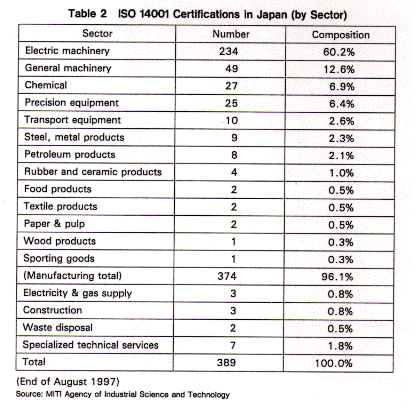
| Although there are no certifications in the transport, distribution, and restaurant sectors, where reduction of environmental burdens has been highly effective, some companies are studying the matter. The finance, insurance, and real estate sectors also have no certifications, but in these sectors progress is slow due to the lack of tangible environmental burdens. However, the non-life insurance sector has shown strong interest in environmental risk.
Globally, there are 1,942 certifications as of this August. The largest proportion belongs to Europe at 67 percent, followed by Asia (including Australia) at 31 percent (Figure 7). By country, England is the highest at 570, followed by Japan and Germany with 200. In Asia, NIEs such as Korea and Indonesia, the ASEAN nations, and China are said to be active. The U.S. is expected to increase in the future as certification becomes a global trend. The difference between Japan, where large companies are the leaders, and Europe is the latter's high participation in sectors with large environmental burdens such as transport and energy supply, and the relative prevalence of second-tier and small and mid-sized companies.
|
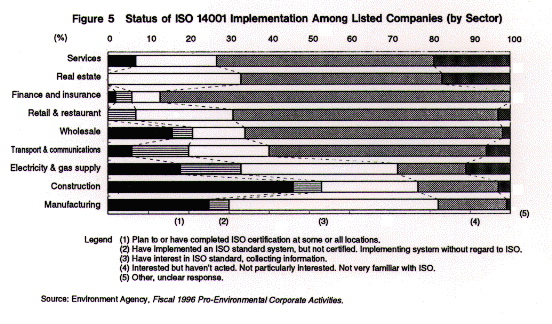
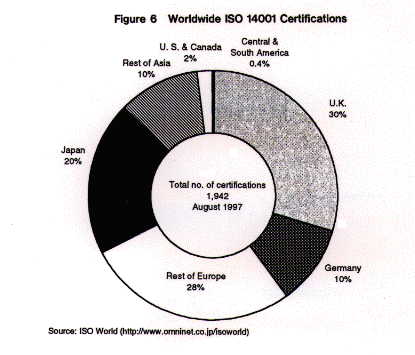
|
4. Impact of ISO 14000 Series There is a strongly rooted view in Japan that acquiring certification is a social responsibility. However, in the future corporate management is likely to confront a variety of environmental problems. How management addresses environmental risks will be a vital point for corporate survival. (1) Advantages and Purposes of ISO 14001 Implementation In general, the advantages of implementing ISO 14001 are that a review of the management system can reduce management costs and avoid potential environmental risks. In business transactions, it can enhance trustworthiness in markets and create a competitive edge in green purchasing networks, wherein purchasers give priority to pro-environmental suppliers. In Japan, the primary reason companies implement or want to implement ISO 14001 is social responsibility (Figure 7). While rationality is important to a company's survival, it will be insufficient in the environmental era of the 21st century. Indeed, the second most common response of corporate survival should be recognized more clearly.
|
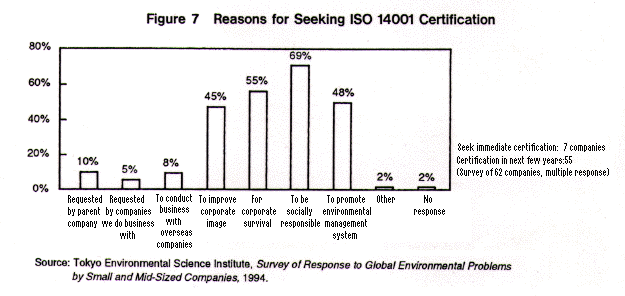
| (2) Recent Developments in ISO 14001
Local governments have shown interest in building environmental management systems and obtaining certification. By taking the lead in implementing ISO 14001, they also intend to produce a ripple effect among second-tier and small and mid-sized companies. Although small and mid-sized companies are by far the most numerous and have a significant impact on the environment, ISO 14001 implementation is being hindered by a lack of information, funds, and personnel. Local governments are thus studying compiling manuals and preferential measures to promote implementation. On the other hand, more local governments are studying whether to require ISO 14001 certification from suppliers of products and services. The Ministry of Construction is studying whether to require suppliers in public works projects (pilot projects) to comply with the ISO 9000 standard for quality control systems, and is likely to also consider ISO 14001 implementation. In response, three associations in the construction industry have compiled handbooks and are actively supporting ISO 14001 implementation in the industry. One manufacturer in Japan, upon obtaining certification, has also officially requested its subcontractors and other companies it does business with to be more environmentally considerate. Other companies that have formulated green purchasing standards are giving priority to suppliers with ISO 14001 certification. With similar developments are occurring in Europe, green companies around the world are beginning to do business with other green companies. In the financial industry, as exemplified by the Superfund lawsuits in the U.S., attention has focused on the problem of potential expense burdens incurred by lenders due to ownership, control, or involvement in the management of businesses that cause environmental pollution. To minimize environmental risks, financial institutions must exercise caution in asset management by investing in businesses that produce few environmental burdens or have low environmental risks. If financial institutions, who have the capability to redistribute assets, focus on environmental considerations in their main line of business, the ripple effects will be substantial. (3) From Social Responsibility to the Green Marketing Era Environmental labeling and LCA standards in the ISO 14000 series will be published by 2000. If these standards become practical international rules that are required for doing business, then the implementation of environmental management systems will of course become a fundamental requisite. To avoid environmental risk themselves, companies will need to demand compliance from the companies they do business with. With LCA, which assesses environmental burdens at all stages ranging from materials procurement to manufacturing, consumption, and waste disposal, the competitiveness of products and services will depend not only on quality and price but environmental factors as well. Given this, while it is important for companies to have a sense social responsibility, they will need to formulate green marketing strategies that seriously look at green purchasing trends and environmental risks of businesses. This will require corporate management to make the environment an essential concern for survival in the coming era of the environment.
|

















